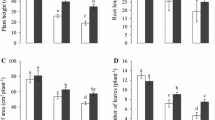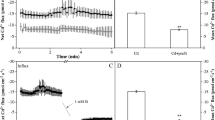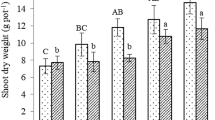Abstract
Silicon (Si) is as an important fertilizer element, which has been found effective in enhancing plant tolerance to variety of biotic and a-biotic stresses. This study investigates the Si potential to alleviate zinc (Zn) toxicity stress in cotton (Gossypium hirsutum L.). Cotton plants were grown in hydroponics and exposed to different Zn concentration, 0, 25, and 50 μM, alone and/or in combination with 1 mM Si. Incremental Zn concentration in growth media instigated the cellular oxidative damage that was evident from elevated levels of hydrogen peroxide (H2O2), electrolyte leakage, and malondialdehyde (MDA) and consequently inhibited cotton growth, biomass, chlorophyll pigments, and photosynthetic process. Application of Si significantly suppressed Zn accumulation in various plant parts, i.e., roots, stems, and leaves and thus promoted biomass, photosynthetic, growth parameters, and antioxidant enzymes activity of Zn-stressed as well unstressed plants. In addition, Si reduced the MDA and H2O2 production and electrolyte leakage suggesting its role in protecting cotton plants from Zn toxicity-induced oxidative damage. Thus, the study indicated that exogenous Si application could improve growth and development of cotton crop experiencing Zn toxicity stress by limiting Zn bioavailability and oxidative damage.




Similar content being viewed by others
References
Abbas G, Khan MQ, Jamil M, Tahir M, Hussain F (2009) Nutrient uptake, growth and yield of wheat (Triticum aestivum) as affected by zinc application rates. Int J Agric Biol 11:389–396
Adriano D (2001) Trace elements in terrestrial environments: biogeochemistry, bioavailability, and risks of metals. Springer Verlag, New York
Aebi H (1984) Catalase in vitro. Methods Enzymol 105:121–126
Akhtar KP, Aslam M, Haq MA, Jamil FF, Khan AI, Elahi MT (2005) Plant pathology and nematology. J Cott Sci 9:175–181
Ali S, Farooq MA, Jahangir MM, Abbas F, Bharwana SA, Zhang GP (2013a) Effect of chromium and nitrogen form on photosynthesis and anti-oxidative system in barley. Biol Plant 57:785–791
Ali S, Farooq MA, Yasmeen T, Hussain S, Arif MS, Abbas F, Bharwana SA, Zhang GP (2013b) The influence of silicon on barley growth, photosynthesis and ultra-structure under chromium stress. Ecotoxicol Environ Saf 89:66–72
Basta NT, Gradwohl R, Snethen KL, Schroder JL (2001) Chemical immobilization of lead, zinc and cadmium in smelter-contaminated soils using bio-solids and rock phosphate. J Environ Qual 30:1222–1230
Beauchamp C, Fridovich I (1971) Superoxide dismutase: improved assays and an assay applicable to acrylamide gels. Anal Biochem 44(1):276–287
Bonnet M, Camares O, Veisseire P (2000) Effects of zinc and influence of Acremonium lolii on growth parameters, chlorophyll fluorescence and antioxidant enzyme activities of ryegrass (Lolium perenne L. cv Apollo). J Exp Bot 51:945–953
Bradford MM (1976) A rapid and sensitive method for the quantification of microgram quantities of protein utilizing the principle of protein-dye binding. Anal Biochem 72(1):248–254
Broadley MR, White PJ, Hammond JP, Zelko I, Lux A (2007) Zinc in plant. New Phytol 173:677–702
Cakmak I (2000) Tansley review no. 111. Possible roles of zinc in protecting plant cells from damage by reactive oxygen species. New Phytol 146:185–205
Chen HM, Zheng CR, Tu C, She ZG (2000) Chemical methods and phytoremediation of soil contaminated with heavy metals. Chemosphere 41:229–234
Cocker KM, Evans DE, Hodson MJ (1998) The amelioration of aluminum toxicity by silicon in higher plants: solution chemistry or an in planta mechanism. Physiol Planta 104:608–614
Currie HA, Perry C (2007) Silica in plants: biological, biochemical and chemical studies. Ann Bot 23:1–7
Cuypers A, Vangronsveld J, Clijsters H (1999) The chemical behavior of heavy metals plays a prominent role in the induction of oxidative stress. Free Radic Res 31:839–843
Cuypers A, Vangronsveld J, Clijsters H (2001) The redox status of the plant cells (AsA and GSH) is sensitive to zinc imposed oxidative stress in roots and primary leaves of Phaseolus vulgaris. Plant Physiol Biochem 39:657–664
Degenhardt B, Gimmler H (2000) Cell wall adaptations to multiple environmental stresses in maize roots. J Exp Bot 51:595–603
Dembitsky VM, Rezanka T (2003) Natural occurrence of arseno compounds in plants, lichens, fungi, algal species, and microorganisms. Plant Sci 165:1177–1192
Dhindsa RS, Dhindsa PP, Thorpe TA (1981) Leaf senescence, correlated with increased level of membrane permeability and lipid peroxidation, and decreased levels of superoxide dismutase and catalase. J Exp Bot 32:93–101
Dionisio-Sese ML, Tobita S, (1998) Antioxidant responses of rice seedlings to salinity stress. Plant Sci 135:1–9
Drazkiewice M (1994) Chlorophyll-occurrence, function and mechanism of action. Environ Exp Bot 42:1–10
Ehsan S, Ali S, Noureen S, Farid M, Shakoor MB, Aslam A, Bharwana SA, Tauqeer HM (2013) Comparative assessment of different heavy metals in urban soil and vegetables irrigated with sewage/industrial waste water. Ecoterra 35:37–53
Ehsan S, Ali S, Noureen S, Mehmood K, Farid M, Ishaque W, Shakoor MB, Rizwan M (2014) Citric acid assisted phytoremediation of Cd by Brassica napus L. Ecotoxicol Environ Saf 106:164–172
Epstein E (1994) The anomaly of silicon in plant biology. Proc Nat Acad Sci USA 91:11–17
Epstein E (1999) Silicon. Annu Rev Plant Physiol Mol Biol 50:641–664
Falkengren-Grerup U, Linnermark N, Tyler G (1987) Chemosphere 16:2239
Farid M, Ali S, Shakoor MB, Bharwana SA, Rizvi H, Ehsan S, Tauqeer HM, Iftikhar U, Hannan F (2013a) EDTA assisted phytoremediation of cadmium, lead and zinc. Int J Agron Plant Prod 4(11):2833–2846
Farid M, Shakoor MB, Ehsan S, Ali S, Zubair M, Hanif MS (2013b) Morpho- logical, physiological and biochemical responses of different plant species to Cd stress. Int J Chem Biochem Sci 3:53–60
Gong H, Zhu X, Chen K, Wang S, Zhang C (2005) Silicon alleviates oxidative damage of wheat plants in pots under drought. Plant Sci 169:313–321
Gong HJ, Randall DP, Flowers TJ (2006) Silicon deposition in root reduces sodium uptake in rice (Oryza sativa L.) seedlings by reducing bypass flow. Plant Cell Environ 29:1970–1979
Gong HJ, Chen KM, Zhao ZG, Chen GC, Zhou WJ (2008) Effects of silicon on defense of wheat against oxidative stress under drought at different developmental stages. Biol Plant 52:592–596
Gonzalez LF, Rojas MC, Perez FJ (1999) Diferulate and lignin formation is related to biochemical differences of wall-bound peroxidases. Phytochem 50:711–717
Gurmani AR, Bano A, Najeeb U, Zhang JL, Khan SU, Flowers TJ (2013) Exogenously applied silicate and abscisic acid ameliorate the growth of salinity stressed wheat (Triticum aestivum L) seedlings through Na+ exclusion. Aus J Crop Sci 7(8):1123–1130
Han FX, Banin A, Su Y, Monts DL, Plodinec MJ, Kingery WL, Triplett GE (2002) Industrial age anthropogenic inputs of heavy metals into the pedosphere. Naturwissenschaften 89:497–504
Hattori T, Inanaga S, Araki H, An P, Morita S, Luxov AM, Lux A (2005) Application of silicon enhanced drought tolerance in Sorghum bicolor. Physiol Plant 123:459–466
Heath RL, Packer L (1968) Photoperoxidation in isolated chloroplasts: I. Kinetics and stoichiometry of fatty acid peroxidation. Arch Biochem Biophys 125(1):189–198
Kaya C, Tuna AL, Sonmez O, Ince F, Higgs D (2009) Mitigation effects of silicon on maize plants grown at high zinc. J Plant Nutr 32:1788–1798
Küpper H, Lombi E, Zhao FJ, McGrath SP (2000) Cellular compartmentation of cadmium and zinc in relation to other elements in the hyperaccumulator Arabidopsis halleri. Planta 212:75–84
Liang Y, Si J, R¨Omheld V (2005) Silicon uptake and transport is an active process in Cucumis sativus. New Phytol 167:797–804
Liang Y, Sun W, Zhu YG, Christie P (2007) Mechanisms of silicon-mediated alleviation of abiotic stresses in higher plants: a review. Environ Pollut 147:422–428
Luo YM, Christie P, Baker AJM (2000) Soil solution Zn and pH dynamics in non- rhizosphere soil and in the rhizosphere of Thlaspi caerulescens grown in a Zn/Cd contaminated soil. Chemosphere 41:161–164
Luo ZB, He XJ, Chen L, Tang S, Chen F (2010) Effects of zinc on growth and antioxidant responses in Jatropha curcas seedlings. Int J Agric Biol 12:119–124
Marschner H (1995) Mineral nutrition of higher plants, 2nd edn. Academic, London, pp 411–430
Miller GW, Huang IJ, Welkie GW, Pushnik JC (1995) Function of iron in plants with special emphasis on chloroplasts and photosynthetic activity. In Iron Nutrition in Soils and Plants. Springer Netherlands, pp 19–28
Ming DF, Pei ZF, Naeem MS, Gong HJ, Zhou WJ (2012) Silicon alleviates PEG-induced water-deficit stress in upland rice seedlings by enhancing osmotic adjustment. J Agron Crop Sci 198:14–26
Mittler R, Vanderauwera S, Gollery M, Breusegem FB (2004) Reactive oxygen gene network of plants. Trends Plant Sci 9:490–498
Morina F, Jovanovic LJ, Mojovic M, Vidovic M, Pankovic D, Veljovic-Jovanovic S (2010) Zinc-induced oxidative stress in Verbascum thapsus is caused by an accumulation of reactive oxygen species and quinhydrone in the cell wall. Physiol Plant 140:209–224
Nakano Y, Asada K (1981) Hydrogen peroxide is scavenged by ascorbate- specific peroxidase in spinach chloroplasts. Plant Cell Physiol 22:867–880
Neumann D, Nieden UZ (2001) Silicon and heavy metal tolerance of higher plants. Phytochem 56:685–692
Pei ZF, Ming DF, Liu D, Wan GL, Geng XX, Gong HJ, Zhou WJ (2010) Silicon improves the tolerance to water-deficit stress induced by polyethylene glycol in wheat (Triticum aestivum L.) seedlings. J Plant Growth Regul 29:106–115
Putter J, Becker R (1974) Methods of enzymatic analysis. Academic Press, Chicago
Rao AR, Dayananda C, Sarada R, Shamala TR, Ravishankar GA (2007) Effect of salinity on growth of green alga Botryococcus braunii and its constituents. Bioresour Technol 98:560–564
Rogalla H, Romheld V (2002) Role of leaf apoplast in silicon-mediated manganese tolerance of Cucumic sativus L. Plant Cell Environ 25:549–555
Shi XH, Zhang CC, Wang H (2005) Effect of Si on the distribution of Cd in rice seedlings. Plant Soil 272:53–60
Szlek M, Miller GW, Welkie GW (1990) Potassium effect of iron stress in tomato plants. 1. The effect on pH, Fe-reductase and chlorophyll. J Plant Nutr 13:215–219
Tewari RK, Kumar P, Sharma PN (2008) Morphology and physiology of zinc-stressed mulberry plants. J Plant Nutr Soil Sci 171:286–294
Zhang J, Kirkham MB (1994) Drought-stress-induced changes in activities of superoxide dismutase, catalase, and peroxidase in wheat species. Plant Cell Physiol 35(5):785–791
Zhao FJ, Lombi E, Mcgrath SP (2003) Assessing the potential for zinc and cadmium phytoremediation with the hyperaccumulator Thlaspi caerulescens. Plant Soil 249:37–43
Acknowledgments
The authors thank the Higher Education Commission of Pakistan for the financial support. The results presented in this paper are a part of M. Phil studies of Shad Ali Anwaar.
Author information
Authors and Affiliations
Corresponding author
Additional information
Responsible editor: Philippe Garrigues
Rights and permissions
About this article
Cite this article
Anwaar, S.A., Ali, S., Ali, S. et al. Silicon (Si) alleviates cotton (Gossypium hirsutum L.) from zinc (Zn) toxicity stress by limiting Zn uptake and oxidative damage. Environ Sci Pollut Res 22, 3441–3450 (2015). https://doi.org/10.1007/s11356-014-3938-9
Received:
Accepted:
Published:
Issue Date:
DOI: https://doi.org/10.1007/s11356-014-3938-9




